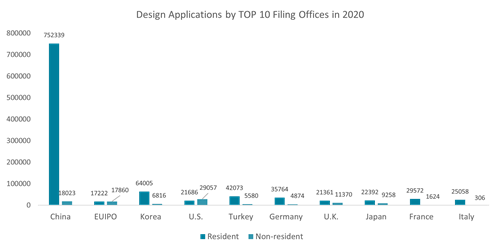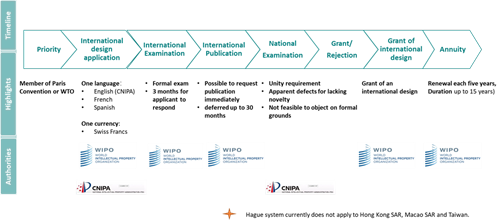The Hague Agreement enters into force in China on 5 May 2022, and China becomes the 77th member of the Hague Union. This milestone indicates that China has deeply participated in the global intellectual property governance under the WIPO framework and China’s design patent registration system is officially going global.
Why design registrations in China?
Industrial designs play an important role in helping build strong, competitive and resilient protection. According to McKinsey’s survey, “Companies that excel at design grow revenue and shareholder returns at nearly twice the rate of their industry peers”. In addition, design rights can be applied to a wide range of innovations covering almost all visible products in life.
Design is a type of patent in China, and only registered design patents can be protected and enforced. For more than ten years, the number of design applications in China has maintained the fastest growth in the world. Especially in recent years, the number of design applications from China has exceeded 50% of the global design registration volume each year, which is mainly contributed by Chinese domestic companies and individuals. China has become the top receiver for design registrations and is almost seven times of the EUIPO in second place.
 Data source: WIPO Statistics Database, February 2022
Data source: WIPO Statistics Database, February 2022
Why the Hague System?
The Hague System provides a straightforward solution for international design protection without the need for filing individual design applications in each country.
Even before China joined the Hague System, some large Chinese companies with subsidiaries or operations in the Hague member states, such as Xiaomi and Lenovo, had been using the Hague System to file international design applications, which confirms the benefits of the system to China based multinational companies.
With the accession to the Hague System, applicants from China will benefit from a more time-efficient and cost-effective solutions to obtain design protections not only in China but worldwide. This is especially true for SMEs without subsidiaries or operations abroad which will use the system to protect their designs overseas. It will be beneficial to foreign applicants as well - if the design application filed through the Hague system meet the requirement of the China Patent Office (CNIPA), the design application would become valid in China without the need of entrusting China local agents.
What do you need to know?
A summary of key points about the basics for filing international design registrations.
Filing: The international design registration can be filed directly with WIPO or before CNIPA, which was appointed as the Patent Office for indirect filing. Chinese is not yet an official language for international design registration and applicants may choose one language from English, French and Spanish. Official fees are payable to WIPO at the time of filing.
International examination / publication: WIPO will conduct a formality examination of the design application and standard publication will take place in twelve months from filing, which was recently extended from six months from January 1, 2022. This will allow designers more time to plan marketing strategy whilst keeping designs confidential.
National examination: CNIPA continues independent examination on novelty and unity of the international design applications. The national examination will be initiated upon the publication of the international design application and CNIPA will notify WIPO of the examination result in 12 months.
It is possible to cover up to 100 designs in one international design application but only up to 10 similar designs are allowed to be incorporated in one Chinese design application. Therefore, applicants may need to file divisional applications for the international design applications with more than 10 designs. These divisional design applications will be dealt with the same as domestic applications.
A remedy procedure is available and is similar to a domestic design application if the CNIPA issues objections to an international design application.
In addition, ownership transfer will be examined independently by the CNIPA even after it is registered with WIPO in the international examination stage.
Grant: An international design certificate will be issued by WIPO where design applications are allowed. The objection of a design application in other countries will not impact the validity of the international design registration in China, and vice versa. CNIPA will publish the grant of the international design registration in Chinese after the grant of the international design registration.
Enforcement: Only a granted design patent can be enforced before a court in China. There is no procedure available for the current stage to seek for temporary protection after the publication of an international design application and prior to its grant, as it does to invention patent applications.
 The process of filing an international design application designating CNIPA
The process of filing an international design application designating CNIPA
Conclusion
In general, design registration through the Hague system is more time efficient and cost effective for designers seeking protection of a unique design worldwide, and with China’s accession to the Hague Agreement, international design applications in and from China will therefore be quick and simple. However as some countries may have specific requirements on formal and substantive aspects of a design application, it is critical to assess these potential issues prior to filing, in order to select the appropriate sets of designs to take advantage of this international design registration system.
Beyond the benefits, it is critical for applicants to be aware that they may incur a relatively large expense at an early stage because designation fees covering all the countries of interest will need to be paid at the time of filing. Therefore, applicants should consider all the facts to form a consolidated and complex filing strategy. But now design applications through Hague system is one of the options.